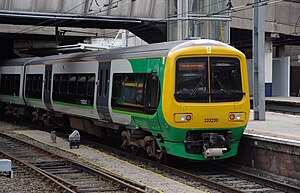British Rail Class 323
| British Rail Class 323 | |
|---|---|

London Midland Class 323 No. 323220 at Birmingham New Street
|
|

The interior of a London Midland refurbished Class 323
|
|
| In service | 1992 - present |
| Manufacturer | Hunslet TPL |
| Order no. |
|
| Built at | Hunslet TPL Leeds |
| Replaced | Class 304 |
| Constructed | 1992–1993 |
| Entered service | 1992 |
| Number built | 43 trainsets |
| Formation | 3 cars per trainset: DMSO(A)+TSOL+DMSO(B) |
| Diagram |
|
| Fleet numbers |
|
| Capacity |
|
| Operator(s) | |
| Depot(s) | |
| Line(s) served |
Cross-City Line Chase Line Rugby-Birmingham-Stafford Line Glossop Line Crewe to Manchester Line Stafford to Manchester Line |
| Specifications | |
| Car body construction | Aluminium alloy |
| Car length |
|
| Width | 2.80 m (9 ft 2 in) |
| Height | 3.78 m (12 ft 4 7⁄8 in) |
| Doors | Bi-parting sliding plug |
| Articulated sections | 3 |
| Maximum speed | 90 mph (145 km/h) |
| Weight |
|
| Traction motors | 4 × Holec DMKT 52/24 |
| Power output | 1,168 kW (1,566 hp) |
| Electric system(s) | 25 kV 50 Hz AC Overhead |
| Current collection method | Brecknell Willis Pantograph |
| UIC classification | Bo'Bo'+2'2'+Bo'Bo' |
| Bogies |
|
| Braking system(s) | Regenerative, Air Brake (Westcode) |
| Safety system(s) | |
| Coupling system |
|
| Multiple working | Class 313-323 |
| Track gauge | 1,435 mm (4 ft 8 1⁄2 in) standard gauge |
The British Rail Class 323 electric multiple units were built by Hunslet Transportation Projects. They were built from January 1992 through to September 1995, although mock-ups and prototypes were built and tested in 1990 and 1991. Forty-three 3-car units were built for inner-suburban services in and around Birmingham and Manchester. These trains are used by Northern and London Midland.
In the early 1990s the Regional Railways sector of British Rail placed an order for new EMUs both to replace older electric units around Birmingham and Manchester, and to work services on the newly electrified Birmingham Cross-City Line. In June 1990, the contract was awarded to Hunslet Transportation Projects of Birmingham, a new company set up by a team of engineers and managers who had left Metro Cammell. Metro Cammell was at the time a Birmingham-based train builder. They won the contract in competition with six other European train builders.
Initially 37 units were ordered, with the option for fourteen more, eighteen would be needed for the Cross-City Line, while the remainder would replace older units (such as the Class 304 and Class 310) in the event a total of 43 three-car units were actually built, numbered in the range 323201-243. Each unit is formed of two outer driving motor vehicles (each equipped with four Holec DMKT 52/24 asynchronous traction motors), and a central intermediate trailer with a Brecknell Willis High Speed pantograph for collecting the overhead current of 25 kV AC. The technical description of the unit formation is DMSO+PTSO+DMSO. Individual vehicles are numbered as follows:
In general, the last two digits of the vehicle number correspond to the last two digits of the set number, such that unit 323227 is formed of 64027+72227+65027. The last four PTSO vehicles are numbered in a separate range to avoid clashing with Class 365 vehicles.
...
Wikipedia
